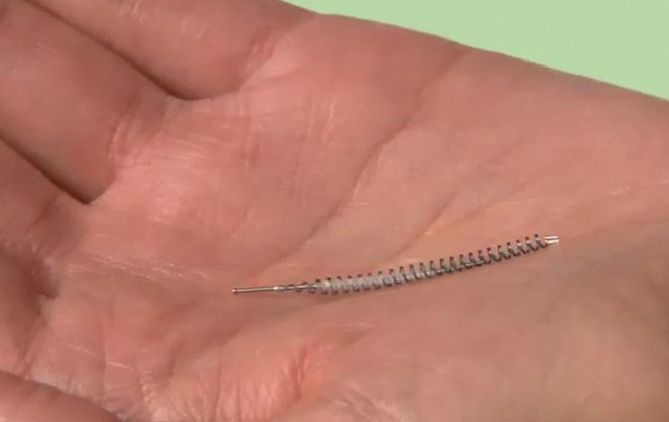 There’s been something of a public backlash against Bayer’s permanent contraception solution, Essure in recent years.
There’s been something of a public backlash against Bayer’s permanent contraception solution, Essure in recent years. There’s been something of a public backlash against Bayer’s permanent contraception solution, Essure in recent years. However is much of the furor simply overamplified by media hype and a few key individuals, or is this medical device truly much more dangerous than alternatives in the market?
There’s been something of a public backlash against Bayer’s permanent contraception solution, Essure in recent years. However is much of the furor simply overamplified by media hype and a few key individuals, or is this medical device truly much more dangerous than alternatives in the market?Essure has been developed as an alternative to surgery and it appears that, at least on paper, it serves its purpose well. Safety data from the manufacturer, submitted to the Food and Drug Administration, shows that 2.0% of patients in a clinical trial had perforations and 2.5% experienced severe pelvic or lower abdominal pain a year later. How those figures compare to the numbers of women suffering from the alleged post-tubal sterilization syndrome is unclear because the latter has never been studied.
Nevertheless, the number of women dissatisfied with the procedure appears to be growing, although how many patients opted to have the device removed is unknown. Erin Brockovich, famed consumer advocate who launched campaign against Essure, claims to have received a “thousand” stories from women who wish they could take the procedure back, and over 14 thousand women have visited her website created as a part of her campaign. Additionally, at the time of writing, the petition put forward by Brockovich to take the drug off the market has received 5,863 signatures, and an anti-Essure Facebook page has amassed 2,859 “likes”.
Despite much hype, the evidence against Essure, a controversial form of permanent contraception for women marketed by Bayer, appears to be merely anecdotal.
According to a study published in an International Journal of Obstetrics and Gynecology in 2012, of the 4306 women who underwent the procedure to receive the implant over a period seven years in the Andalusia Health Service in Cordoba, Spain; only 115 (2.7%) reported complications, none of which required hospitalization.
Fainting was the most common side effect, occurring in 85 (2.0%) of the cases. In 19 cases one device was expelled. The scientists concluded that sterilization using Essure is safe and has a low rate of complications, but perhaps the study should be taken with a dose of skepticism, as the authors have received expenses from the manufacturer to attend scientific meetings and congresses.
Nevertheless, a study conducted by researchers without declared conflict of interest at the Andre Mignot Hospital in Le Chesnay, France, showed 97.6% effectiveness and 2.6% complication rate, corroborating the recommendation made in 2007 by the French National Health Authority that the technique be the first-line treatment for women around the age of 40, seeking permanent contraception.
“Essure” generates 21,100 hits in Google Scholar at the time of writing. Ten randomly selected papers that studied the safety and effectiveness of Essure support the findings of the Spanish and French teams. Search in PubMed, an electronic database for biomedical and health sciences, yields 160 results. Again, ten papers were randomly selected for closer inspection, out of which eight reported favorable safety and effectiveness profile (one described pregnancies in women who had the device fitted, resulting from either off label use or not following the protocol; the second one described the benefits of sterilization in an office setting).
Alternative Therapies
Essure is a replacement for a traditional surgical approach called tubal ligation (tubectomy). In this method, fallopian tubes are clamped or blocked, severed or sealed. It is a non-reversible procedure performed under general anesthesia – with mortality rate of 4 per 100,000 – and is generally believed to be 99% effective in the first year. In the following years, some evidence suggests, there is a chance that the fallopian tubes will reconnect leading to conception, but 15-20% of pregnancies will be ectopic.
While the main risk associated with the procedure is down to general anesthesia, the list of side-effects is long, with some talking of post-tubal sterilization syndrome. Adverse effects include abnormal bleeding and pain, chronic fatigue, stabbing sensation under the skin, tingling in the extremities, and pelvic pain, among others, all similar to the side effects experienced by women suffering after having fitted Essure, suggesting that the adverse events reported are not disproportionately severe compared to traditional methods of permanent contraception. While the exact cause of the post-tubal sterilization syndrome is unknown – and its existence is controversial – the suspected mechanism behind it is loss of blood flow to the ovaries.
Nonetheless, Tamara Callahan, M.D., assistant professor of Obstetrics and Gynecology at Vanderbilt University, who performs both procedures, insists that Essure is safer than traditional tubal ligations. “Laparoscopy has been great, but it’s a bigger deal. There are 350,000 laparoscopic tubals done in operating rooms every year with up to a 3 percent complication rate – that’s 10,000 complications every year that could potentially be avoided. The bottom line is we have something that’s highly effective, safer, and more convenient for the patient. There’s less down time – a day at the most, compared to four or five days,” she saidpointing out that the percentage of people affected by side effects is not disproportionately high.
Moreover, Joseph Gregory, an analyst covering medical devices for GlobalData, said that the claims that the procedure does not work or that it should be recalled are “inappropriate” and “unsubstantiated.” “While the reported adverse cases are very serious and represent potential issues with the Essure device, or the procedure itself, they have to be considered in reference to how many patients in total have utilized and benefitted from this procedure,” he commented.
According to Bayer, Essure has been implanted in over 750,000 women since it was approved in 2002, and is considered 99.83% effective, although another method of contraception is recommended over the first three months after implantation. Available in 18 countries, it has not, so far, been removed from any market due to questionable safety or effectiveness profile. It is recommended as an alternative to surgical procedures, which carry risks associated with general anesthesia, and procedure-specific side-effects.
Controversy
Public outcry over safety and efficacy is nothing new to healthcare. Occasionally, sadly, such responses are perfectly valid, however oftentimes shock and panic are amplified by media coverage, online campaigns and famous faces. In such instances, the din of protest can easily overshadow the facts and prevent people from seeing the full story.
Between Dec 31, 2006 and Jan 1, 2013, 597 reports of adverse events related to Essure were submitted to the FDA, although on their own they say nothing about the scale of the problem. “The FDA relies on a variety of postmarket surveillance data sources to monitor the safety and effectiveness of medical devices. [While] adverse event and product problem reports submitted to the FDA … are a valuable source of information, this type of reporting system has notable limitations,” said Synim Rivers, a spokesman for the FDA, in a statement for eyeforpharma. Complaints or adverse events reports do not necessarily directly indicate a faulty or defective medical device, and so adverse event reports alone cannot be used to establish or compare rates of event occurrence.
Gregory added: “Although the adverse event profile may seem immensely large when highlighted, it isn’t large enough to surpass 1%. What’s more, it’s likely that this rate is even smaller given that most noted physicians have likely performed more than one of these procedures,” he said.
Rivers elaborated: “Essure is a class III device that received the FDA’s most stringent and rigorous review prior to marketing, using our pre-market approval (PMA) process. PMA approval is based on a determination by the FDA that the PMA contains sufficient valid scientific evidence to ensure that the device is safe and effective for its intended use(s),” the FDA statement read.
Nevertheless, Amanda Yunker, M.D., also from Vanderbilt University, began looking at possible problems with Essure when women started coming to her with pain. “When I started taking them out and found that their pain resolved, then we realized that, yes, Essure can cause pain in a small subset of patients,” Yunker said.
Dr. Yunker studied more than 450 women who had Essure put in at Vanderbilt and said she found about 4% or so have had continuing problems like pain, which she said is a relatively small percentage.
Implications
Meanwhile, Bayer have released a statement in which they express sadness over any serious health conditions affecting patients using their products, but stress that Essure was approved by the FDA in 2002, and has a “well-documented benefit-risk profile, with over 400 peer-reviewed publications and abstracts supporting Essure’s safety, efficacy and cost-effectiveness.”
They also emphasize that a recent practice bulletin issued by the American College of Obstetricians and Gynecologists has recognized that Essure has high efficacy and low procedure-related risk, cost, and resource requirements, further adding that no birth control is without risk and should be considered appropriate for every woman.
Last month Bayer requested that the FDA allow them to change the patient information booklet to include the most common complaints reported by the women. They will include additional information about “risks of chronic pelvic pain and device migration.” They were reluctant to comment on whether or not they considered tweaking the device, or whether they will offer some form of support for women who suffer from side effects.
What does it all mean for women negatively affected by the procedure? “The FDA takes reports of safety concerns seriously. We continue to monitor the safety of Essure to make certain that it does not pose an increased risk to public health and safety and that its benefits of providing women with a non-surgical sterilization choice continue to outweigh the risks of the device,” Rivers wrote. She was unwilling to speculate about what would happen to women who had fitted Essure if the device were to be removed from the market, an event that is unlikely to occur.
Healthcare is an incredibly personal service, both to provide and receive, and while industry professionals might know that eliminating side effects entirely is an impossibility for this very reason, members of the public who have suffered these adverse effects are oftentimes not as informed. Cases like Essure underline the importance of clear communication of the risks as well as a need for the industry to paint the bigger picture for concerned members of the public. Yes there is a possible risk to receiving treatment, is that risk any larger or more pronounced than that of its competitors? Not according to the evidence. As always the choice lies with the patient, but unless they’re equipped with all the facts prior to making the decision, they can be left feeling at best cheated should something go awry.








